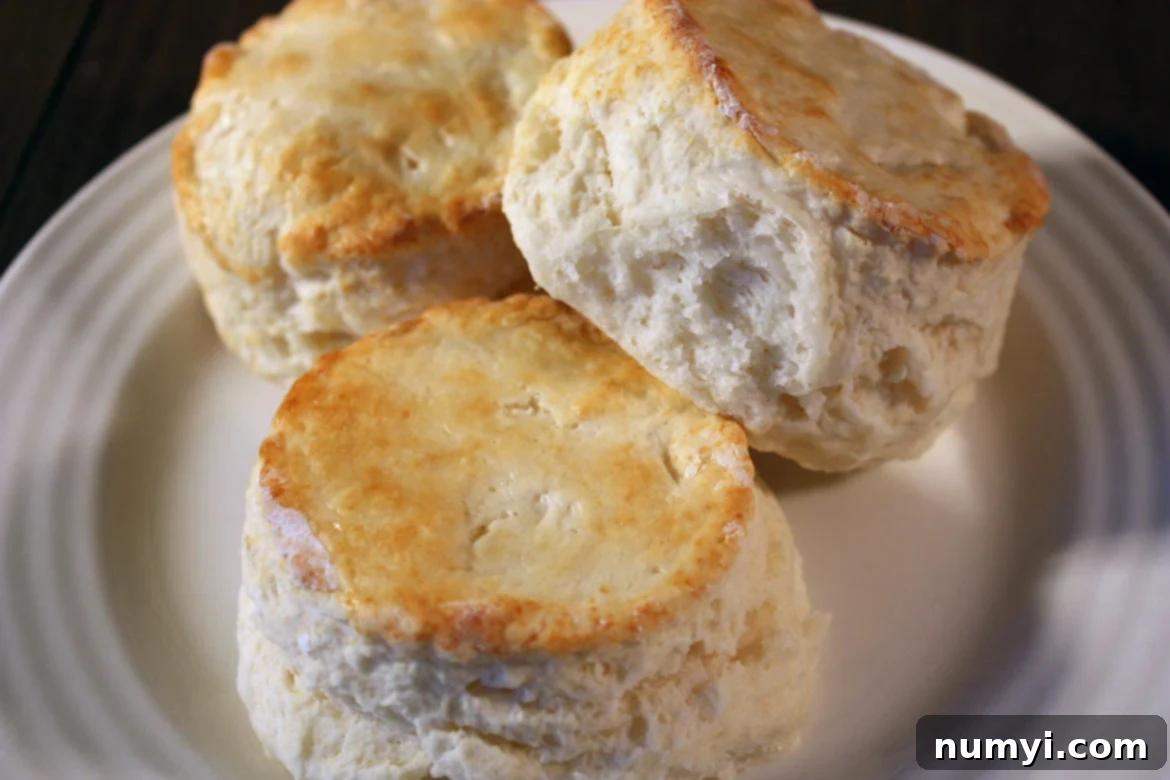Mastering Fluffy Biscuits: The Ultimate Easy Homemade Buttermilk Recipe
Oh, the joy of a perfectly baked biscuit! After countless attempts and a collection of what could only be described as “hockey pucks,” I’ve finally cracked the code to making the most incredible, easy homemade buttermilk biscuits. This isn’t just any biscuit recipe; it’s the one that delivers light, airy, and tender results every single time, complete with a delightful, slightly crispy bottom that makes them truly irresistible. You’re about to discover a method that transforms basic ingredients into a breakfast (or anytime) masterpiece, all thanks to insights gleaned and perfected, inspired by resources like themerchantbaker.
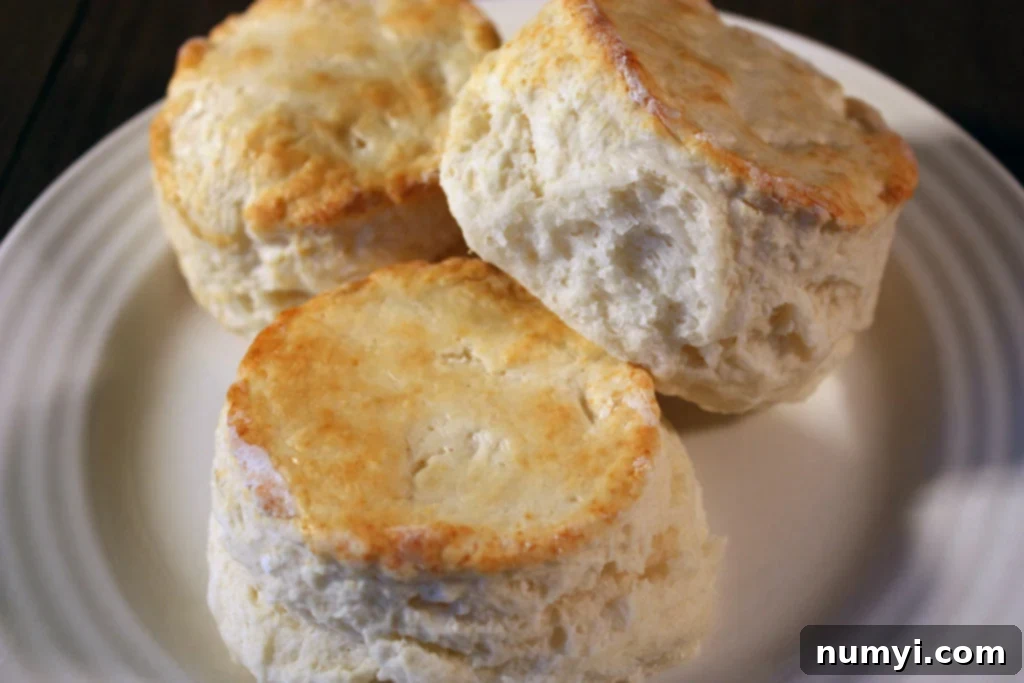
Why You’ll Fall in Love with This Buttermilk Biscuit Recipe
If you’ve ever struggled to achieve those coveted light, fluffy, and tender homemade biscuits, you’re not alone. I spent years producing dense, disappointing results. But through trial and error, I’ve perfected a recipe that consistently yields tall, flaky, and unbelievably delicious buttermilk biscuits. This isn’t just about baking; it’s about transforming simple ingredients into a comforting staple that will impress your family and friends. This easy buttermilk biscuit recipe has become such a beloved favorite in our home that my husband requests them almost every weekend. Once you taste these perfectly baked, golden-brown beauties with their tender crumb and slightly crispy exterior, you’ll understand why!
What makes these biscuits stand out? It’s a combination of precise technique and the right ingredients, meticulously balanced to create that ideal Southern-style texture. They are incredibly versatile, perfect for breakfast with jam and butter, as a comforting side for a hearty dinner, or even as the base for a savory breakfast sandwich. This recipe truly takes the guesswork out of making biscuits, empowering even novice bakers to create culinary magic. Forget those past baking mishaps; this is the recipe that will change your biscuit-making game forever, allowing you to enjoy truly impressive homemade biscuits with minimal fuss.
Looking for more delicious breakfast inspirations? Be sure to check out some of our other family favorites like Ham and Cheese Strata, Buttermilk Cranberry Orange Muffins, Hearty Hashbrown Breakfast Casserole, Overnight Maple Bacon Baked French Toast, and our delightful Blueberry Baked Oatmeal. Each recipe is designed to bring comfort and flavor to your morning table.
Watch How to Make Fluffy Homemade Buttermilk Biscuits (Video Guide)
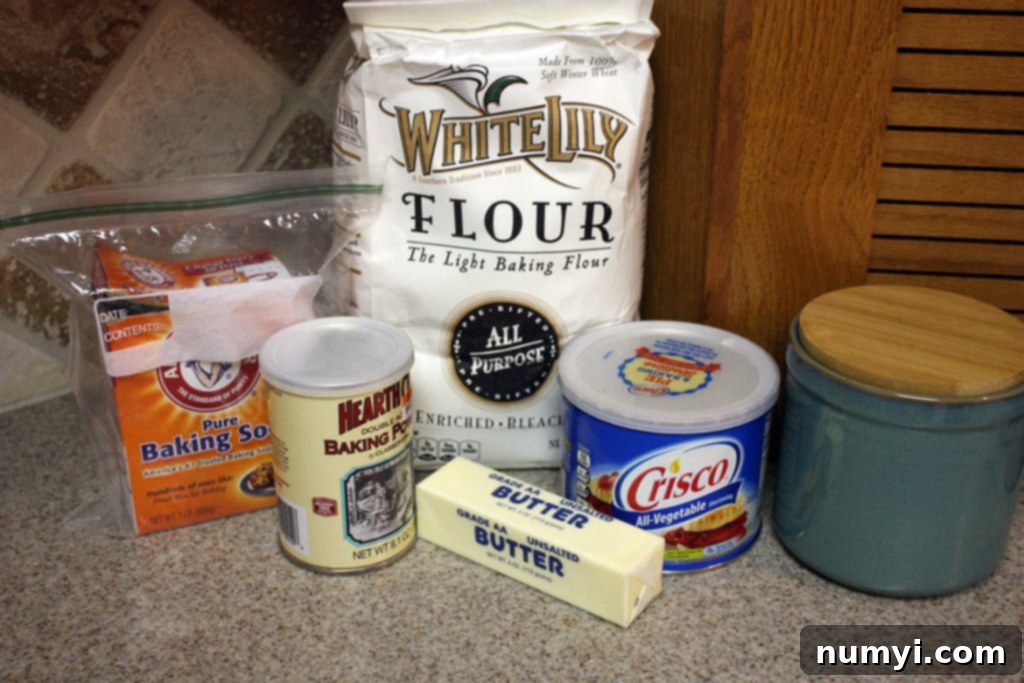
Essential Ingredients for Perfect Buttermilk Biscuits
Crafting the perfect, fluffy biscuit begins with understanding the role each ingredient plays. Quality and proper temperature are absolutely key! Here’s what you’ll need to create these wonderfully flaky and tender homemade biscuits:
- All-purpose flour – This is the primary building block, forming the structure of our delightful biscuits. Proper measurement is crucial for achieving the right texture. To measure correctly, first, aerate your flour by fluffing it gently with a spoon. Then, lightly spoon it into your measuring cup until it overflows, and finally, level it off with a straight edge (like the back of a knife). This technique prevents compaction, which can lead to dense, heavy biscuits instead of light, airy ones.
- Baking soda, baking powder, and salt – These are your powerful leavening agents and essential flavor enhancers. The baking powder and baking soda work synergistically with the natural acidity of the buttermilk, initiating a chemical reaction that produces carbon dioxide bubbles. These bubbles are trapped within the dough, causing it to rise beautifully and creating its signature airy, tender texture. Always ensure your baking powder and baking soda are fresh by checking their expiration dates; old leavening agents will result in flat, unrisen biscuits. Salt, while seemingly simple, is vital for balancing the flavors and enhancing the overall savory taste of the biscuit.
- Unsalted butter – It’s paramount that your butter is *ice cold* and cut into small cubes. Using cold butter is the secret weapon for creating those coveted flaky layers. As the tiny pockets of cold butter melt in the hot oven, they release steam, which pushes apart the layers of dough. This separation results in an incredibly light, layered, and flaky crumb that melts in your mouth. I highly recommend unsalted butter so you have complete control over the total salt content in your recipe, allowing you to adjust to your personal preference.
- Shortening – Just like the butter, your shortening must be *cold*. Shortening contributes significantly to the tender, soft texture of the biscuit and helps maintain its classic tall shape during baking. It works in harmony with the butter to achieve that perfect flaky, yet melt-in-your-mouth quality without adding excess moisture, making your homemade biscuits truly special. For best results, use a non-hydrogenated shortening.
- Buttermilk – Keep your buttermilk *very cold* right up until the moment you add it to the dry ingredients mixture. The inherent acidity in buttermilk is essential as it reacts with the baking soda to help the biscuits rise beautifully. Beyond its leavening properties, buttermilk imparts a subtle tangy flavor and contributes immensely to the tender crumb that makes these Southern-style biscuits so desirable and unique.
(Note: Buttermilk was regrettably absent from the ingredient photo, but rest assured, it’s an absolute star player in this recipe and critical for its success!)
Many traditional biscuit recipes often call for a touch of granulated sugar or honey to add a hint of sweetness. Personally, I find that these savory biscuits don’t need the added sugar, as their rich, buttery flavor shines through beautifully on its own, especially when paired with savory toppings. However, if you prefer a slightly sweeter biscuit, a common preference in some regions, you can certainly add about two teaspoons of granulated sugar to the dry ingredients mixture before whisking. It’s all about personal preference when it comes to customizing your perfect homemade treat.
Step-by-Step Guide: How to Make Easy Homemade Buttermilk Biscuits
Making light and fluffy biscuits at home is a rewarding experience, and with this detailed guide, you’ll achieve perfection every time. Follow these simple steps for the best homemade buttermilk biscuits, focusing on gentle handling and cold ingredients:
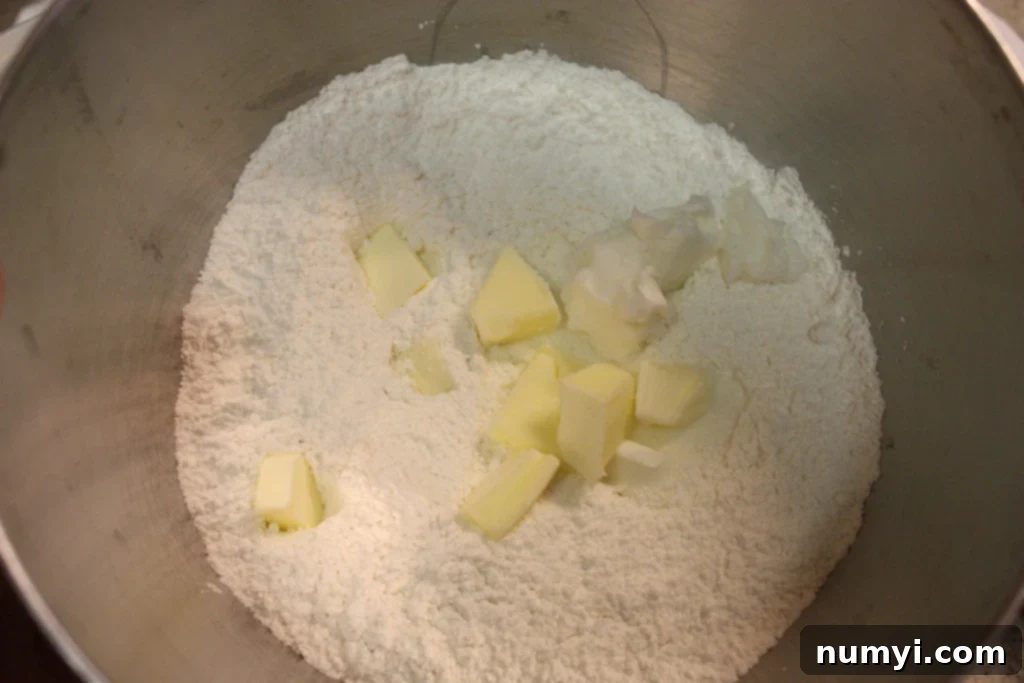
Step 1: Prepare Your Dry Ingredients. Begin by preheating your oven to a hot 450 degrees F (230°C). In a large mixing bowl, meticulously whisk together the all-purpose flour, baking powder, baking soda, and salt. It’s important to ensure these dry ingredients are thoroughly combined and evenly distributed. This foundational step is essential as it guarantees that the leavening agents are spread uniformly throughout the flour, allowing for a consistent and impressive rise in every single biscuit.
Step 2: Incorporate Cold Fats. Next, add your *ice cold* shortening and *cold* cubed butter to the flour mixture. The absolute key here is to maintain the fats’ cold temperature. You have a couple of options: use a pastry blender, which is specifically designed for this task, or work quickly and gently with your fingertips. The objective is to cut the fats into the flour until the mixture resembles coarse meal with some pea-sized pieces of butter and shortening still distinctively visible. Avoid overworking the dough with your hands, as the warmth from your skin can melt the fats prematurely, which would prevent the desired flaky texture from developing.
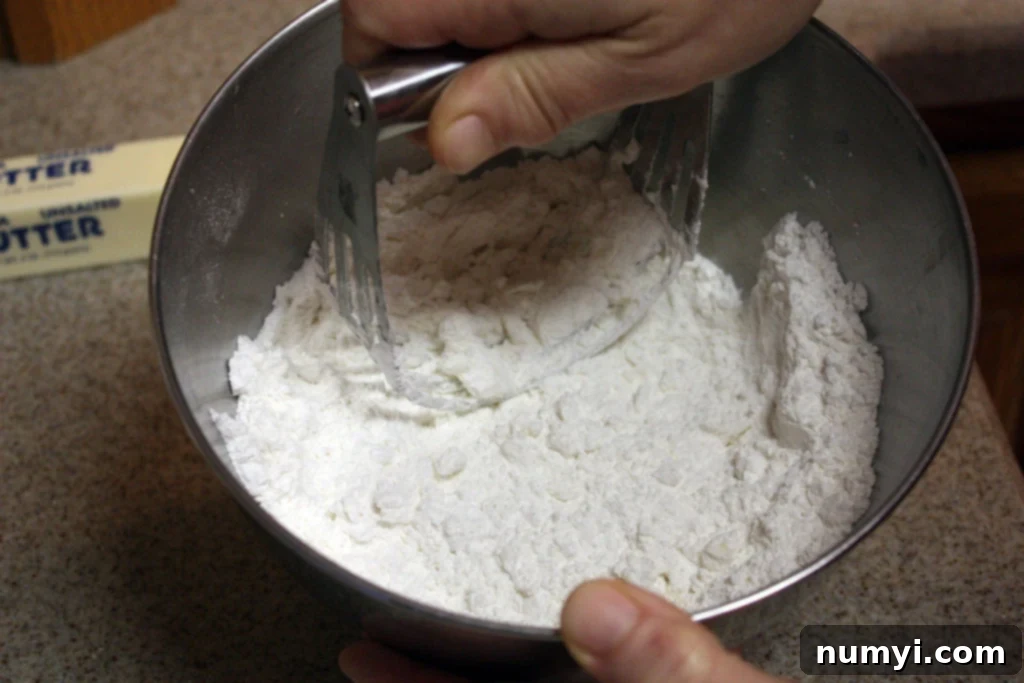
Using a pastry blender is often the preferred method as it minimizes direct contact with warm hands, thereby helping the butter and shortening stay cold and solid. If you choose to use your fingertips, work swiftly and gently, lifting the mixture as you rub the fat into the flour. This critical process creates numerous small pockets of cold fat within the dough. As these pockets melt and create steam during baking, they will push apart the layers of dough, ultimately resulting in countless flaky layers and a wonderfully tender texture in your finished buttermilk biscuits.
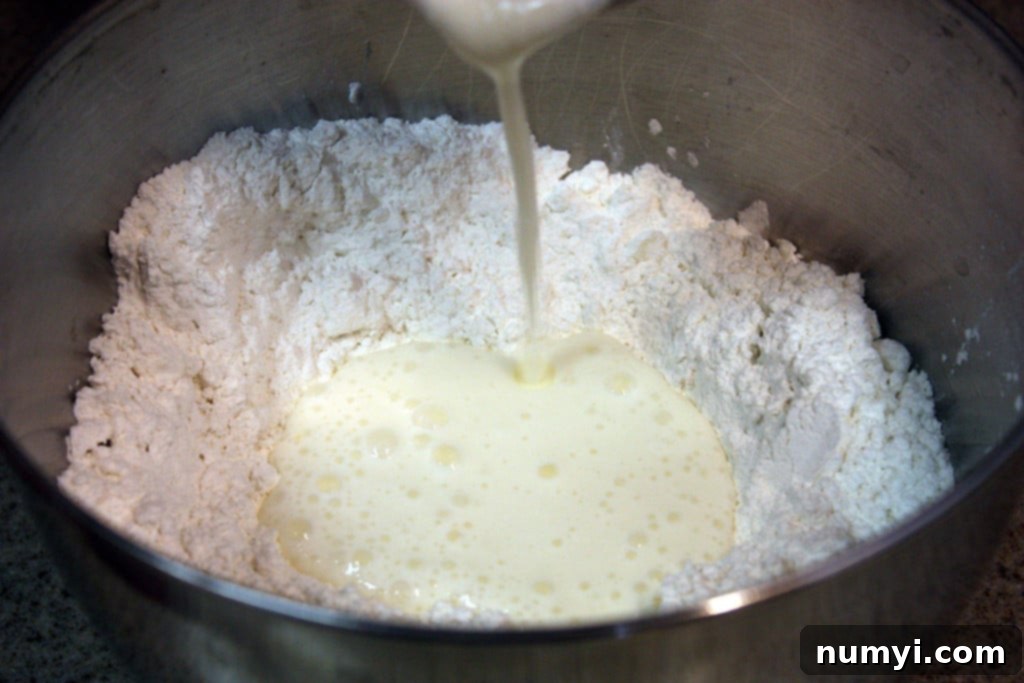
Step 3: Add the Buttermilk. Create a shallow well in the very center of your dry ingredients and fat mixture. Now, pour in the *cold* buttermilk. The temperature of the buttermilk is just as crucial as the fats, as it helps to keep the entire dough cold and prevents the butter and shortening from melting too early, preserving their ability to create those essential flaky layers.
Step 4: Gently Mix the Dough. Using a sturdy wooden spoon or a spatula, begin to incorporate the flour into the buttermilk. Work from the outside of the well, gently scooping the flour towards the center and tossing it with the buttermilk until the liquid is just incorporated and the dough begins to come together. At this stage, the dough will appear somewhat wet and sticky, and that is perfectly normal and desired. **It is absolutely vital not to vigorously stir or overmix** it like you would a cake batter. Overmixing develops the gluten in the flour, which will inevitably result in tough, dense, and dry biscuits instead of the light, tender, and fluffy ones we’re aiming for. A truly light hand is the secret to achieving that desirable soft crumb.
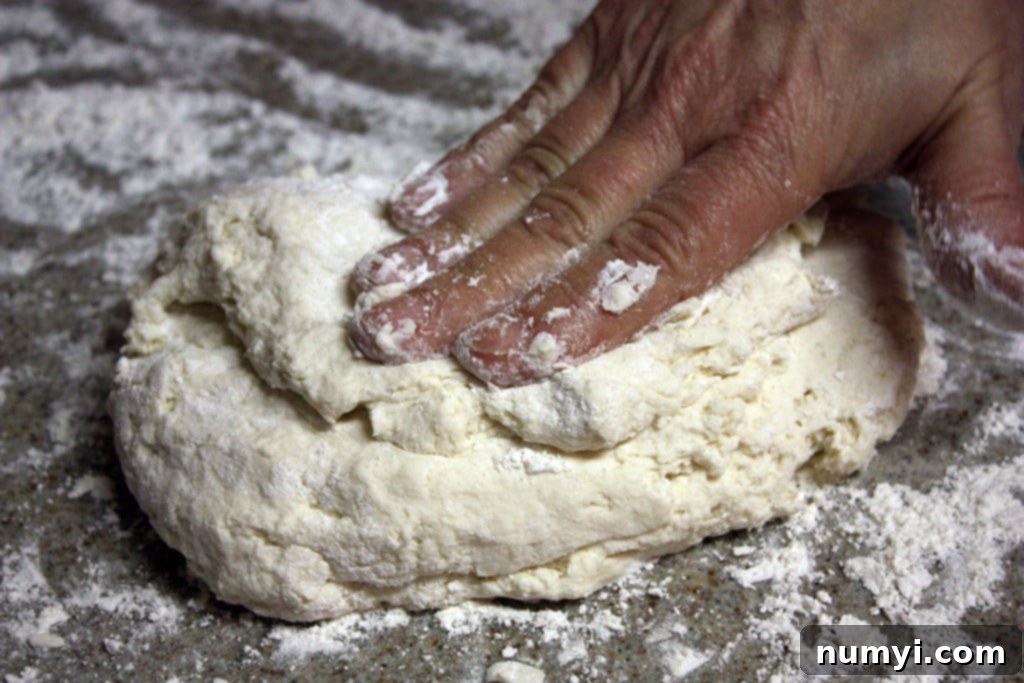
Step 5: Laminate the Dough for Flaky Layers. Turn the wet, sticky dough out onto a generously floured surface. Keep a small pile of extra flour nearby, as you will likely need to lightly flour your hands and the work surface as you handle the dough. Flour your hands, gently bring the dough together into a cohesive mass, and then begin the crucial folding technique that creates those incredible flaky layers. Lightly fold the dough in half, gently press it down, then turn the dough a quarter turn (90 degrees), and fold it in half again. Repeat this folding and turning process about 6 to 10 times, or until the dough starts to come together more smoothly and feels less sticky. This repetitive “lamination” process is what meticulously builds the numerous thin, flaky layers that define a truly great homemade buttermilk biscuit, ensuring a tender and airy result.
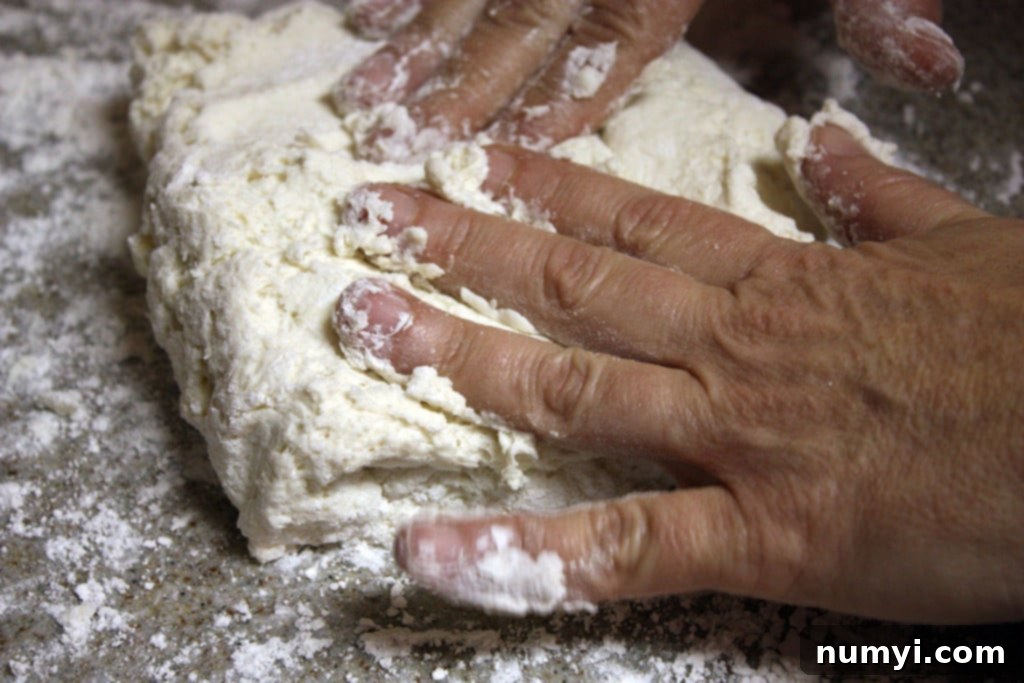
(A small personal note: Please excuse my wrinkled hands in these photos! They served as a strong reminder to invest in those trusty kitchen gloves for future baking sessions. Lesson learned, and hopefully, it adds a touch of authenticity to the home-baking process, showcasing real-life kitchen moments!)
Step 6: Shape and Cut the Biscuits. Once your dough has been sufficiently folded and feels somewhat smoother, gently pat it out with your hands to an even thickness of approximately 1 inch. There’s usually no need for a rolling pin here; using your hands helps to keep the dough tender and prevents unintentional overworking. On this first rollout, cut as many biscuits as you can without twisting. To achieve tall, beautifully risen homemade biscuits, use a lightly floured biscuit cutter or pastry cutter and push it straight down through the dough. **It is incredibly important not to twist the cutter** as you remove it. Twisting seals the edges of the biscuit dough, which severely inhibits its ability to rise fully and create distinct, separate layers, resulting in a shorter, denser biscuit.
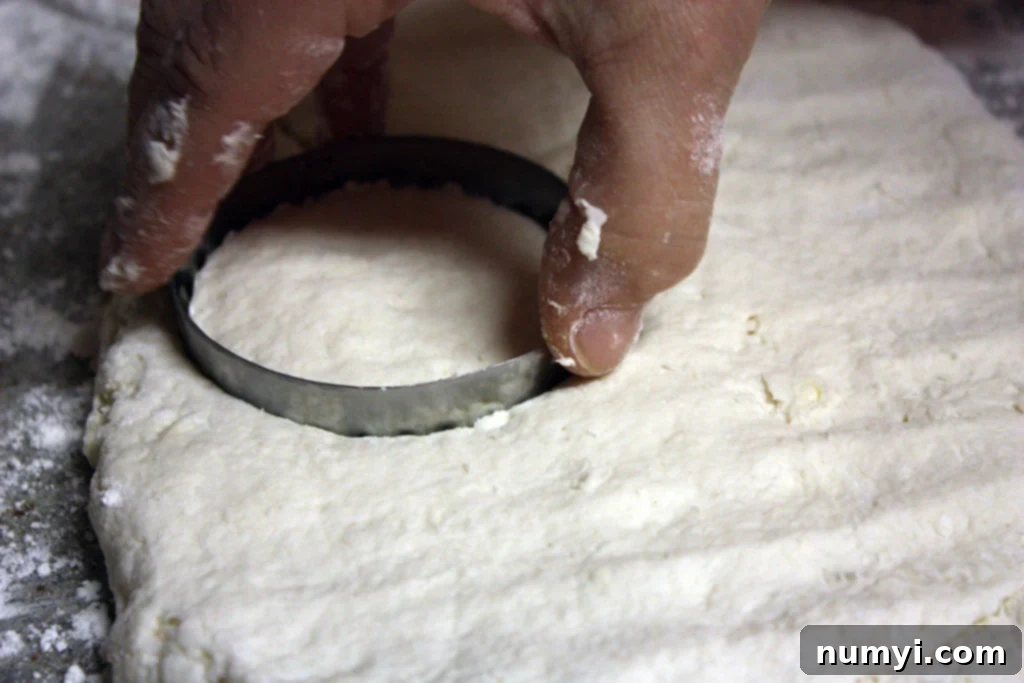
After your initial cuts, gently gather the remaining dough scraps. Bring them together very carefully, without overworking them, pat the dough out again to the desired thickness, and cut more biscuits. Be aware that these second-cut biscuits may not rise quite as high or be as flaky as the first batch due to increased handling, but they will still be absolutely delicious and worth baking.
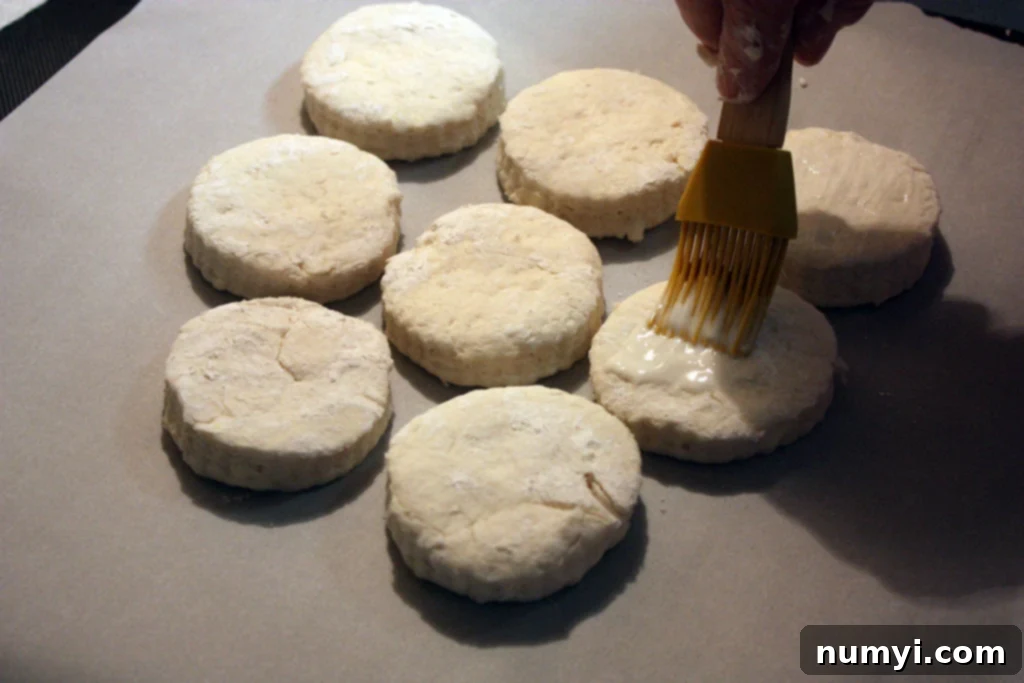
Step 7: Arrange and Bake. For the very best rise and beautifully soft sides, turn the cut biscuits upside down on a parchment paper-lined baking sheet. Arrange them almost touching each other. This close proximity creates a steamy environment during baking, which encourages the biscuits to push against each other and grow taller rather than spreading outwards. This method also helps to keep their sides wonderfully soft. Lightly brush the tops of the biscuits with a little extra buttermilk for a beautiful golden-brown crust and a slight sheen. Place them into your preheated 450-degree F oven and bake for approximately 15 minutes, or until they are impressively tall, gloriously golden brown on top, and thoroughly cooked through. The enticing aroma alone will tell you they are ready!
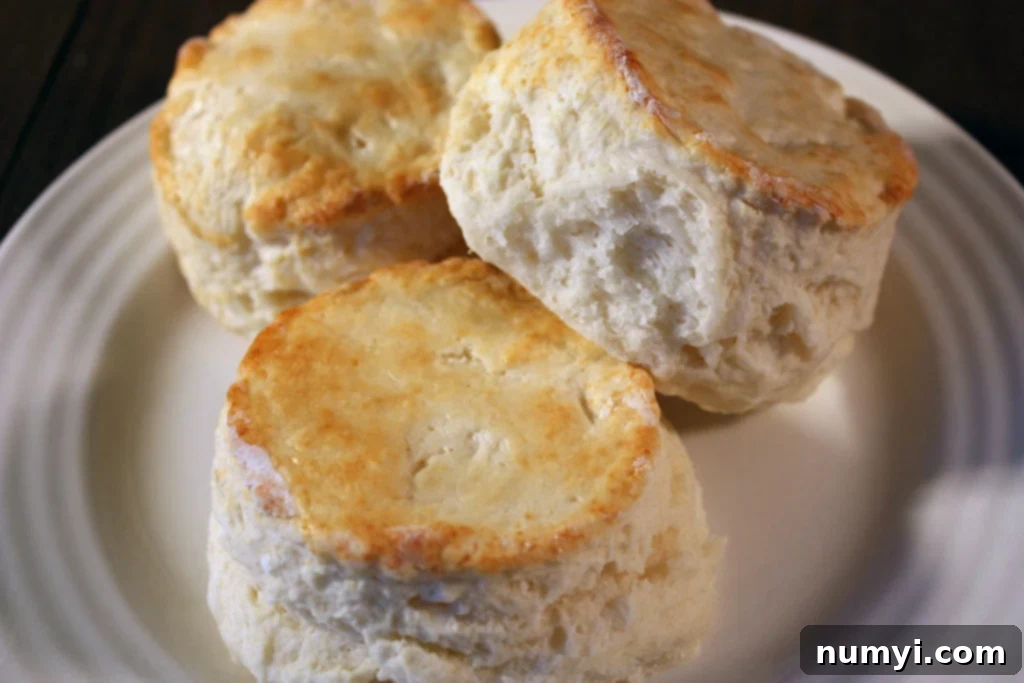
Just look at these beauties fresh out of the oven! The consistently golden-brown tops, the impressive, lofty rise – they are truly a sight to behold and the aroma is simply heavenly. You’ve just created a batch of perfect homemade buttermilk biscuits that are ready to be devoured, offering an unparalleled taste of Southern comfort.
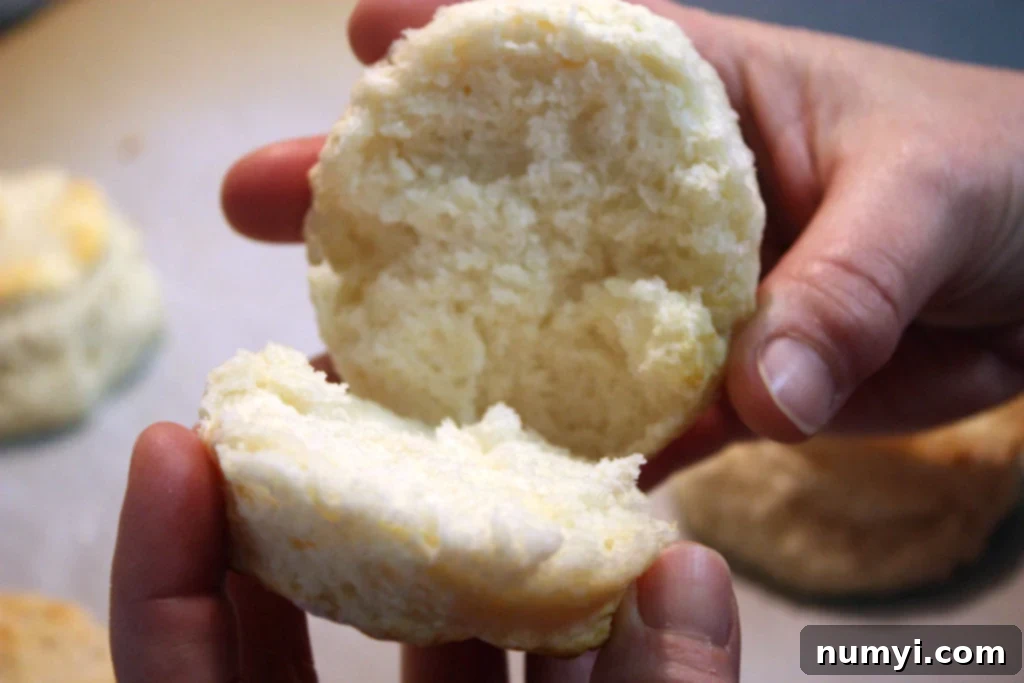
Serve these warm, soft, flaky biscuits immediately for the ultimate enjoyment. They are divine slathered with melted butter, your favorite fruit jam, a generous drizzle of sweet maple syrup, or alongside a rich, savory sausage gravy. The tender crumb and delicate layers are unparalleled. This easy homemade biscuit recipe truly allows anyone to create impressive, restaurant-quality results that will delight friends and family alike. Yielding 6-8 tall, large biscuits, they are perfect for sharing or enjoying throughout the weekend, providing a taste of pure comfort.
These versatile buttermilk biscuits aren’t just for breakfast! While they are undoubtedly fantastic with classic breakfast pairings like sausage gravy or as a side for eggs, they also make a wonderful accompaniment to fried chicken, a hearty stew, chili, or even as the base for small sandwiches with deli meats and cheeses. Their light texture and subtle savory flavor make them a perfect bread option for almost any meal, proving their utility far beyond just morning meals. Thinking about your next culinary adventure to serve alongside these? You absolutely need to try our Fried Grit Cakes recipe! Imagine these fluffy biscuits alongside those savory, crispy grit cakes… pure breakfast (or brunch, or dinner!) heaven!
Top Tips for Baking the Best Buttermilk Biscuits
Achieving consistently perfect, fluffy, and tender buttermilk biscuits isn’t solely about the ingredients; it’s also profoundly about the technique and understanding the science behind each step. Here are our top tips, elaborated with explanations, to ensure your homemade biscuits turn out beautifully and deliciously every single time:
- Keep Your Ingredients Cold: This is arguably the most crucial tip, foundational to flaky biscuits! Ensure your buttermilk, butter, and shortening are kept very cold—ideally chilled—until the very moment you incorporate them into the mixture. Cold fats create distinct, tiny pockets within the dough. As these pockets of fat melt in the hot oven, they release steam, which meticulously pushes apart the layers of dough. This separation results in those highly desirable, light, and unmistakably flaky biscuits. Conversely, using warm fats will cause them to be absorbed by the flour, leading to dense, heavy, and less appealing biscuits.
- Make Your Own Buttermilk: Don’t have any buttermilk on hand? No problem! You can effortlessly make a perfectly acceptable substitute at home. Simply add 1 tablespoon of fresh lemon juice or white vinegar to a liquid measuring cup. Then, add enough whole milk (or 2% milk) to reach the 1-cup line. Stir the mixture gently and let it sit undisturbed for about 10 minutes. During this time, the milk will curdle slightly and thicken, forming a rich, acidic buttermilk substitute that is perfect for reacting with the baking soda in this recipe.
- Do Not Overwork the Dough: This is a common pitfall for many biscuit bakers. Once you’ve added the buttermilk, your goal is to mix the dough just until it barely comes together and no dry streaks of flour remain. Overmixing the dough aggressively develops the gluten in the flour, which makes biscuits tough, chewy, and bread-like rather than soft and tender. Always use a very light hand and stop mixing as soon as the ingredients are combined.
- Hands Over Rolling Pin: While a rolling pin can be a useful tool in baking, for biscuits, using your hands to gently pat and shape the dough is often preferred and highly recommended. This hands-on approach prevents over-compression of the dough and allows you to maintain a light, delicate touch, which is absolutely vital for developing and preserving a tender crumb. Aim for an even thickness of about 1 inch.
- Lamination for Layers: The folding and turning technique (as detailed in step 5 of the instructions) is essentially a simple yet effective form of dough lamination. Each gentle fold creates new, distinct layers of butter within the dough. As these precise layers bake, the embedded butter melts and releases steam, which physically pushes the dough apart, forming those incredible, numerous, and airy flaky layers that are the hallmark of a truly exceptional, artisanal-quality biscuit.
- Don’t Fear Extra Flour: When you turn the wet, sticky dough out onto your work surface, do not hesitate to use a little extra flour on both your surface and your hands. This prevents the dough from sticking excessively, allowing you to handle it gently and confidently without accidentally incorporating an overwhelming amount of additional flour into the dough itself. The primary objective is to make the dough manageable, not dry it out.
- Cut Straight Down, No Twisting: This tip is paramount for maximum rise. When using your biscuit cutter, push it straight down into the dough and pull it straight back up. **Under no circumstances should you twist the cutter.** Twisting the biscuit cutter seals the edges of the dough layers, which can significantly prevent the biscuit from rising fully and evenly, often resulting in lopsided, shorter, or less flaky biscuits. A clean, straight cut allows the delicate layers to expand freely upwards without restriction.
- Place Biscuits Almost Touching: Arrange your cut biscuits on the baking sheet so they are nearly touching each other. This strategic placement creates a steamy, cooperative environment during baking, which encourages the biscuits to push against each other and rise taller rather than spreading outwards. This method also significantly helps to keep their sides beautifully soft and tender. Biscuits that bake independently tend to spread more and develop crispier, sometimes drier, edges.
- Brush with Buttermilk (or Butter): Before baking, lightly brushing the tops of your biscuits with a little extra buttermilk will give them a gorgeous golden-brown color and a slightly crisp, appealing top crust. For an even richer flavor, a deeper golden sheen, and a touch more indulgence, you could also opt to brush them with a small amount of melted unsalted butter.
Frequently Asked Questions About Homemade Buttermilk Biscuits
Biscuits are always best enjoyed fresh and warm, straight from the oven, when their texture is at its peak. However, if you happen to have any delicious leftovers, it’s important to allow them to cool completely to room temperature before storing them. Once cooled, place them in an airtight container or a resealable freezer bag to protect them from drying out, and store them at room temperature for up to 2 days. To reheat and revive their warmth and softness, wrap them loosely in aluminum foil and warm them in a 300°F (150°C) oven for a few minutes until heated through. I strongly advise against using the microwave for reheating, as it can make them notoriously chewy and significantly diminish their wonderful, tender texture. Alternatively, for a pleasant crispness, you can slice them in half and lightly toast them in a toaster or under the broiler.
Absolutely! Freezing baked biscuits is a fantastic way to prepare ahead and enjoy them later, ensuring you always have a homemade treat on hand. Once your biscuits have cooled completely to room temperature, arrange them in a single layer (if possible) within an airtight freezer-safe container or a heavy-duty freezer bag. They will maintain their best quality, flavor, and texture for up to 2 months in the freezer. To reheat from frozen, simply transfer them directly to a baking sheet and warm them in a 350°F (175°C) oven for approximately 15-20 minutes, or until they are heated through and regain their desirable soft interior.
Yes! Freezing unbaked biscuits is an excellent meal prep hack, allowing you to have fresh-baked biscuits in minutes on any given day. Follow the recipe instructions all the way through the cutting step. Instead of baking them immediately, carefully place the cut, unbaked biscuits on a parchment-lined baking sheet, ensuring they don’t touch each other. Freeze them until they are completely solid (this usually takes about an hour or two). Once frozen solid, transfer them to a zip-top freezer bag or an airtight container, and they can be stored in the freezer for up to 3 months. This way, you can bake fresh, warm biscuits whenever the craving strikes!
Baking frozen unbaked biscuits is incredibly convenient and yields fantastic results. Preheat your oven to 450°F (230°C). Line a baking sheet with parchment paper and arrange the frozen biscuits on it, placing them almost touching, just as you would with fresh dough. Brush the tops with a little extra buttermilk (or melted butter) for a beautiful golden crust. Bake them as instructed in the recipe, but be prepared to add a few extra minutes to the baking time, typically around 18-20 minutes total, until they are beautifully golden brown, impressively risen, and fully cooked through. This method provides the joy of freshly baked biscuits without all the immediate prep work!
Explore More Delicious Biscuit Recipes
If you’ve enjoyed mastering these classic, fluffy buttermilk biscuits, you’ll be thrilled to discover other wonderful variations to add to your baking repertoire. Biscuits are incredibly versatile, and there’s always a new flavor profile or texture to explore, offering endless possibilities for breakfast, brunch, or dinner. Here are a few more delightful biscuit recipes from our kitchen that we think you’ll love, each offering a unique twist on this beloved comfort food:
Easy Homemade Butter Swim Biscuits
Easy Homemade Buttermilk Drop Biscuits Recipe
Cheddar Chive Biscuits

Easy Homemade Biscuit Recipe (tender, soft, and flaky)
Print
Pin
Rate
Ingredients
- 2 cups all-purpose flour
- 4 teaspoons baking powder
- 1/4 teaspoon baking soda
- 3/4 teaspoon salt
- 2 Tablespoons salted or unsalted butter (cold and cut into cubes)
- 2 Tablespoons shortening I use non-hydrogenated
- 1 cup cold buttermilk
- extra buttermilk for brushing tops
Instructions
-
Preheat oven to 450 degrees F (230°C).
-
In a large mixing bowl, whisk together the all-purpose flour, baking powder, baking soda, and salt until well combined and evenly distributed.2 cups all-purpose flour, 4 teaspoons baking powder, 1/4 teaspoon baking soda, 3/4 teaspoon salt
-
Using a pastry blender or your fingertips, quickly cut the cold shortening and butter into the flour mixture until it resembles coarse meal with some pea-sized pieces of fat remaining. Work quickly to keep the fats cold.2 Tablespoons salted or unsalted butter, 2 Tablespoons shortening
-
Make a well in the center of the dry ingredients and pour in the cold buttermilk.1 cup cold buttermilk
-
Using a wooden spoon, gently bring the flour from the outside into the buttermilk in the center. Mix with a light hand, just until the buttermilk is incorporated and the dough begins to come together. Do not overmix; the dough will be wet and sticky.
-
Turn the wet, sticky dough out onto a generously floured surface. Keep a small pile of extra flour handy for your hands and surface as needed.
-
Flour your hands, gently bring the dough together, and then lightly fold it in half.
-
Gently turn the dough a quarter turn, fold it in half again, and repeat this process about 5-7 times. This folding creates flaky layers without overworking the dough, making it feel smoother.
-
Pat the dough out with your hands to an even thickness of about 1 inch. Avoid using a rolling pin to maintain a tender texture.
-
Using a lightly floured biscuit cutter, cut the dough by pushing straight down. Do not twist the cutter, as twisting seals the edges and prevents maximum rise. Cut as many biscuits as possible from the first rollout. Gently reform scraps and cut additional biscuits; these may not rise as high.
-
Turn the cut biscuits upside down and place them on a parchment paper-lined (or ungreased) baking sheet, positioning them almost touching each other. This proximity aids in a taller rise and helps keep the sides soft.
-
Lightly brush the tops of the biscuits with a little extra buttermilk for a beautiful golden crust.extra buttermilk for brushing tops
-
Bake in the preheated oven for about 15 minutes, or until the biscuits have risen nice and tall, with golden brown tops and cooked through. Serve warm and enjoy!
Notes
**Avoid Twisting the Biscuit Cutter:** Push straight down and pull up. Twisting seals the edges, which prevents the biscuits from rising to their full, fluffy potential.
**Bake Biscuits Close Together:** Placing the cut biscuits almost touching on the baking sheet helps them rise higher and ensures softer, more evenly baked sides.
**To Freeze Unbaked Biscuits:** Prepare the dough and cut the biscuits. Place them on a parchment-lined baking sheet and freeze until solid. Once frozen, transfer to a zip-top freezer bag and store for up to 3 months.
**To Bake From Frozen:** Preheat oven to 450°F (230°C). Arrange frozen unbaked biscuits almost touching on a parchment-lined baking sheet. Brush tops with buttermilk. Bake as instructed, adding a few extra minutes (approx. 18-20 minutes total) until golden brown and cooked through.
